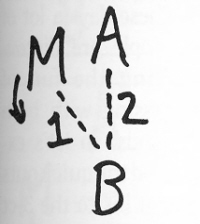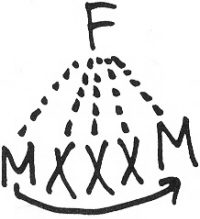|
The
Feed: Outs and Ins
A
handy bit of knowledge to have is how to jump into or out of a
juggling pattern, such as a feed, without disturbing the flow
of the pattern. A common trick is simply to say
"In!" or "Out!" or "Hup!" when
you want to change the pattern. Of course, the folks you're
juggling with have
to know what the possibilities are that you might
intend, so that
they can react properly, but here are some
suggestions.
First,
with three people in a feed (one feeder and two feedees),
either of the feedees can leave the pattern by saying
"Out!" on a pass. The next pass is unaffected, going
as usual between the other two jugglers, so they don't have to
react terribly quickly to adjust the pattern. Starting with
that pass, however, they can simply
switch into a 2-ct (every one) or a 4ct (every other),
depending on local convention. Let's assume for now that they
go into a 4-ct.
Now,
the juggler who left the feed can come back in at any of four
different places and a feed will resume: on the left or right
of either of the two other jugglers. So the "out"
juggler simply picks one of those places (and perhaps an
interesting way to get there) and then calls "In!"
at the right time. For now, just assume you go straight
forward and turn around, changing feeders as a result - see
Fig. 1, where "M" represents the moving juggler.
|
|
If
you're going into a 4-ct, call "In!" at the time of a
R-hand self by the two remaining passers (assuming they're
passing R handed). This again allows the next R hand throw to
be unaffected by the call, in this case being a pass between
the two continuing passers. The next R hand after that,
however, is a pass between the juggler who called
"In!" and the person opposite, who now proceeds to
feed normally.
For
going into a 2-ct, the timing of the "In!" is the
same. Since there is no Rhand self in a 2-d, the call comes
on a pass. The next R-hand throw is not changed, as usual, and
the R after that is the caller's first pass in the resumed
feed. So you always yell "In!" on the second R hand
throw before you want to make your first R hand pass. That's 4
counts before you're really in (a count is one L- or R-hand
throw).
|
|
Going
Out in Style
When
you go out, instead of going straight forward and turning
around to change feeders, you can just move to the other side
of your neighbor feedee and keep the same feeder. Or you can
go beyond that position over next to the old feeder to come
back in. The easy routes in both of these cases go behind one
of your partners. For more of a challenge, try going in front,
right through the pattern, to get to the new position.
Because
you leave the pattern on a pass, when you are going out you
have to catch your partner's last pass to you. You don't have
to keep juggling at that point. Often you want to get to the
next spot as quickly as possible, and that usually entails
just catching the final pass and holding the three clubs as
you move.
With
a bigger feed, it's fun to call "Out!" from one end
and run down to do an "In!" on the other end (Fig.
2). Or move to the feeder's side for a double feed.
|
|
The
calling of "Out!" is to alert your juggling partners
to the fact that something is changing that they must adjust
to, although not necessarily super quickly. You can,
however, just agree
that anyone who moves from one position and immediately is
ready in a new position is "out" and instantly back
"in," eliminating the need for the explicit calls.
With this agreement, we get quick outs and ins. Let's see what
it's like with three people in a feed.
Upon
making a pass, a feedee goes straight forward, catches the
incoming pass short, and turns around quickly, ready to pass
to the new feeder. The sequence of passes exchanged is this:
(1) moving feedee and original feeder; (2) still feedee and
original feeder; (3) moving feedee (now on the other side) and
still feedee (who is the new feeder). See the passes numbered
1 to 3 in Fig. 1.
When
doing this quick out and in, start moving immediately after
your initial pass. As you move forward, put the club from your
L hand into your R hand (Ieaving two clubs in your R). Catch
the original feeder's pass in your L hand while you continue
forward. As soon as you catch that pass, turn quickly by
pivoting on your L foot and then step back on your R, with
your R hand back ready to pass. Make your pass as you see the
new feeder passing to you.
A
fast variation is for only one person to move, doing a quick
out and in with each pass made, first on one side of the
pattern, then on the other, then back on the first side, and
so on. In this case you're rapidly alternating between the two
parts of Fig. 1, with the 4-pass cycle indicated by passes
numbered 1 to 4 in that figure. This is great exercise, as is
the combination below with all three (or more) people moving
whenever possible.
|
|
The
Wheel
In
a feed of any number of people, if every person does the
above-described quick out and in whenever possible, we get a
pattern called the wheel. The basic rule in the wheel is that
each person feeds all the other people once and then runs to
the other side with a quick out and in. Usually we do this
with the feeds moving from left to right, but right to left
gives the same sort of effect.
We'll
start the wheel in a multiple feed formation, with half the
people side by side in one row facing the other half in the
other row, as in a complete feed. If there are an odd number
of people, the extra person is placed at the left end (from own
view) of either row.
|
|





